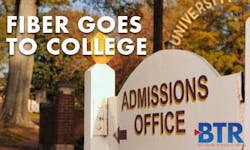The students' needs, paired with the university's own data requirements are leading schools to investigate the best way (read cost effective and least intrusive) to increase capacity and speed. Passive optical LAN (POL) might be the solution they, and the operators wishing to serve them, are looking for, said Eric Presworsky, CTO of Zhone Technologies (NASDAQ:ZHNE).
"The cost and space savings are amazing," Presworsky said. "POL changes the paradigm."
With a more traditional copper-based Ethernet solution, a campus with 40+ buildings, for example, each building would have copper wiring to teacher's offices with one or two Ethernet switches per floor that all feed to a router in the basement. That connects to a campus ring network or semi-mesh or hub-spoke configuration. With POL, a single data center houses the electronic components for the entire campus, and there would be an active component for every eight teachers. Also, while Ethernet can only run 100 meters before it comes to a switch, POL can run 20 km.
"There is cost savings on power, cooling space, and use of space," Presworsky said. "Teachers (for example) could use the wiring closets for other purposes. The way this can play on a campus is massive. (And) think of big campuses in middle America that can have their entire campus controlled by one OLT (optical line terminal) handling tens of thousands of Ethernet ports."
Of course, copper would have to be replaced with fiber throughout the university. Gigabit passive optical networking (GPON) is generally the technology that rides on it, Presworsky said. Unlike with copper, which requires infrastructure upgrades to increase bandwidth, POL is scalable.
"Today, you have 2.5 Gbps, you put another card in for 10 Gbps and then another for 40 Gbps without touching the infrastructure of the university. The lifespan of fiber is 20-60 years. The copper (has to be changed) every few years," Presworsky said.
A cable company could use the same infrastructure to provide its video services, whether they are IP-based or traditional RF. Existing boxes generally are GPON compatible. "The ONTs (optical network terminals) have coax coming out of them that plug into the set-top. (You) can't tell if it is fiber and GPON or coax going back to the headend," Presworsky said.
